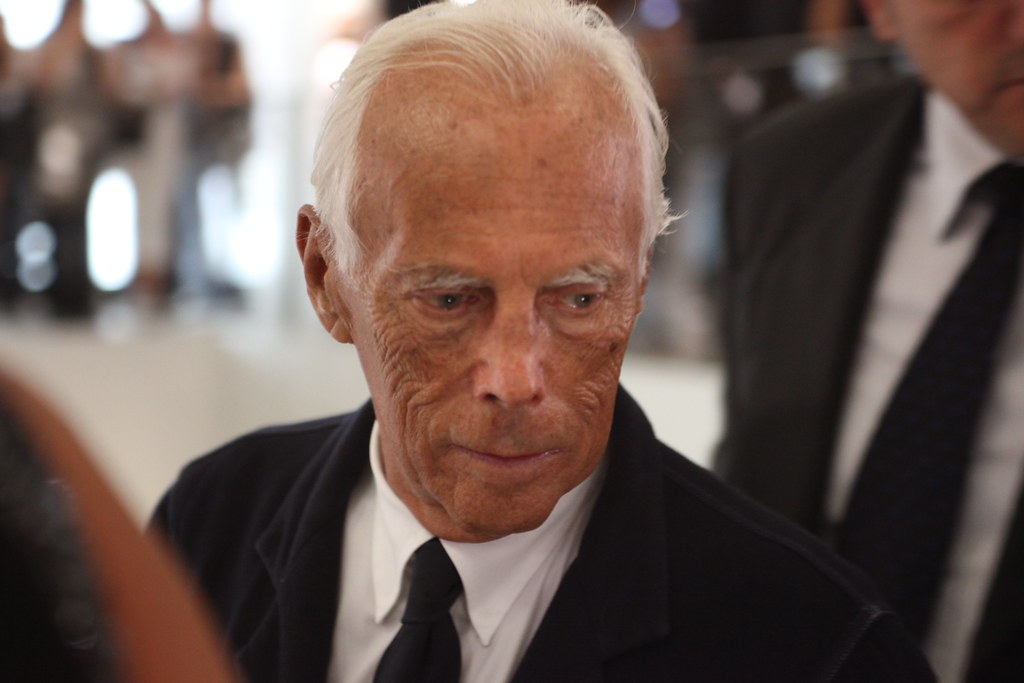Key Takeaways:
• Giorgio Armani built a global brand by dressing movie characters in over 200 films.
• He introduced relaxed, affordable suits to middle-class shoppers in America.
• Hollywood exposure in “American Gigolo” made his style famous worldwide.
• Red carpets and celebrity ties kept his name linked to prestige and power.
• His blend of fabric know-how and media savvy set a model for modern fashion brands.
Why Giorgio Armani Pioneered a New Fashion Era
Giorgio Armani grew up in Piacenza, Italy. He left medical school in 1954 and began working at a top Milan department store. There, he fell in love with fabrics. He saw how designer pieces could be licensed to reach more shoppers. By studying lines from other brands, he learned to balance luxury with affordability.
In 1975, Armani teamed up with Sergio Galeotti to launch his own label. Instead of stiff, formal suits, he created soft, simple tailoring. People loved the fresh, relaxed look. By 1978, he partnered with a major textile group to produce luxury ready-to-wear under close supervision. This deal formed the Giorgio Armani Corporation and started multiple lines for different markets.
Giorgio Armani’s Hollywood Breakthrough
Soon after his brand took shape, Hollywood helped spread his style. In 1980, “American Gigolo” starred Richard Gere wearing light Armani suits. His character could wear the same jacket with a tie or with jeans. The soft materials came from women’s fashion, yet the look stayed sharp. As fashion historian John Potvin noted, the film introduced a new visual style and launched both the designer and the actor’s star power.
Because Armani offered a more affordable line called Armani Collezioni, fans could buy similar pieces in stores. Thus, a casual movie wardrobe became a real-life fashion trend. This was one of the first times a film directly boosted a brand’s image and sales.
Affordable Luxury Hits America
When Giorgio Armani entered the U.S. in 1979, he chose prices that middle-class shoppers could afford. His team used permanent-press fabrics that needed little ironing. They also mixed in cheaper textiles to keep costs down. In Milan, a jacket might cost $600. In New York, Armani’s sports and formal lines sold between $150 and $450.
Furthermore, he tapped Edward Glantz, a former department store buyer, to tailor the products for American taste. Glantz made sure the suits felt easy to wear yet still elegant. Soon, major stores like Bergdorf Goodman stocked the lines. This strategy proved that luxury could fit everyday budgets.
Crafting Power Dressing
By the early 1980s, power dressing became a trend. People wanted clothes that made them look confident and in control. Giorgio Armani’s broad-shouldered suits fit that need perfectly. In 1982, he became only the second fashion designer to grace the cover of Time magazine.
Armani’s approach combined machine and handcrafting. Even though 70 percent of each suit was machine-made and partly produced in Hong Kong, customers saw them as high-quality. His marketing spoke of mastery and precision, reinforcing a top-tier image.
Celebrity Endorsements and Red Carpet Impact
In 1988, Giorgio Armani hired Wanda McDaniel to manage his Hollywood connections. She had once watched a rival boutique pamper VIPs on Rodeo Drive. McDaniel brought that same white-glove service to Armani’s flagship store. Celebrities loved the personal attention.
Soon, Armani designs appeared at award shows. Julia Roberts wore an Armani suit to the 1990 Golden Globes. Commentators raved about the gowns and unisex looks on the red carpet. Armani later said that Oscar night dresses always sold out first. His entertainment relations team still outfits stars for films and events.
In addition, movies like “The Untouchables” and “The Wolf of Wall Street” featured Armani suits on strong, ambitious characters. Each appearance underlined the brand’s link to success and style.
Legacy of Fashion and Film
Giorgio Armani once explained that prestige and dreams drive sales. Hollywood gave him both. Over decades, his name became shorthand for sleek power and modern elegance. He showed other brands how to build in-house teams to court celebrities. His methods shaped the way fashion houses work with film and media today.
Even after more than 200 film credits, Armani never lost his passion for cloth and design. He kept expanding lines to suit different markets, from the most upscale to the more budget-friendly. His life work proves that art and commerce can meet on screen and in stores.
In the end, Giorgio Armani’s genius lay in connecting fabric, film and fame. His suits did more than clothe movie stars. They let people around the world wear a piece of glamour and confidence.
Frequently Asked Questions
What made Armani suits different from other designer brands?
Armani suits used soft, lightweight fabrics and simple cuts. This made them feel relaxed yet elegant. By mixing machine work with hand finishing, he balanced quality with lower costs.
How did “American Gigolo” boost Armani’s profile?
In that 1980 film, Richard Gere’s character wore Armani suits on screen. Millions of viewers noticed the style and wanted similar clothes. This direct link between film and fashion launched his U.S. success.
Why did Armani focus on both luxury and affordability?
After studying licensing at a Milan department store, he saw that middle-class shoppers wanted quality at lower prices. By diversifying his lines, he reached wider markets and drove global growth.
How did Armani use celebrities to grow his brand?
He hired a Hollywood liaison in 1988 to build VIP relationships. Celebrities wore his designs on and off screen. Red carpet events and film roles kept his name in the spotlight and spiked sales.

